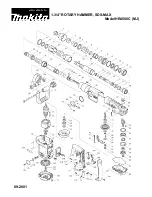
76
Battery
• The extreme increase in temperature of a lithium battery can cause it to ignite or even
explode, causing serious damage to nearby people or the environment. The causes of
this increase in temperature can be the following:
-
Incineration of the battery.
-
Direct and prolonged exposure to the sun (on high temperature days) or to a source of
fire.
-
Electrical over-consumption of the tool to which the battery is connected, when this tool
is subjected to forced work, for example an overloaded grinding wheel.
-
Electrical overload due to connection to a charger for longer than required.
-
Electrical overload due to the connection to a charger with different parameters than
required.
-
Overload due to direct contact between the positive and negative terminals by a
conductive metallic element.
• The increase in temperature can also cause leakage of liquids from the battery, which
could cause poisoning or irritation of the skin or eyes. To avoid this, consider not hitting,
opening or incinerating the battery. Consider also what was stated in the previous point.
In case of skin contact with these liquids, rinse thoroughly with water. In case of contact
with eyes or intoxication, seek medical help.
NOTE:
Our battery is built with a smart electronic system that protects it from electrical
and temperature overloads, increasing security to prevent the battery from suffering
such damage. However, this can not control the actions of users who manipulate it
incorrectly, recklessly and insecurely.
• Never use a battery that is damaged, broken or with defective terminals. There is a
danger of electric shock, leakage of liquids or production of sparks that could cause a
fire. Replace it.
• Never use a charger other than the one recommended. This must be built with the
necessary elements to protect the useful life of the battery, along with the safety of
people and environment.
Li-ion battery use and care
• Before using the charger, read all the instructions for use and the warning marks on
the charger and battery.
• Connect the charger to mains whose voltage is identical to that indicated on its
nameplate.
• Do not pull on the power cord of the charger to disconnect it from the outlet or to
transport it.
• The charger and battery are specifically designed to work together. Do not attempt to
charge the battery with another charger.
• Only use the charger indoors, do not expose it to the weather, high temperatures or
humidity.
• Do not use the charger if it has been subjected to strong blows, or if it has been
dropped or damaged in any way. Take the charger to an authorized service center for
inspection and repair.
• Do not disassemble the charger. Take it to an authorized service center when it
requires service or repair. Improper assembly can cause a fire, electric shock or
electrocution.
DANGER!
If the battery is cracked or damaged, do not insert it into the charger. There is
a danger of electric shock or electrocution.
WARNING!
Do not allow any liquid to come into contact with the charger. There is a risk
of electric shock.
• To reduce the risk of electric shock, unplug the charger from the power supply before
attempting to clean it. Removing just the battery does not reduce the risk.
NOTE:
Our battery charger is built with a smart electronic system that protects the
battery from electrical and temperature overloads in the process of charging power,
disconnecting the electrical connection between both when the battery reaches its
maximum load, thus achieving greater safety.
Charger use and care
75








































